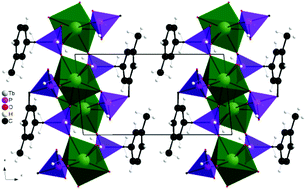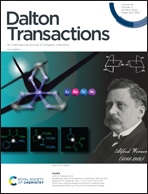Two-dimensional layered lanthanide diphosphonates: synthesis, structures and sensing properties toward Fe3+ and Cr2O72−†
Abstract
A series of lanthanide diphosphonates, namely Ln(HL)(H2O)2 (Ln = Nd 1, Eu 2, Tb 3 and Er 4), have been synthesized from a semirigid diphosphonate ligand, (5-methyl-1,3-phenylene)bis(methylene)bisphosphonic acid (H4L). These lanthanide diphosphonates have been systematically characterized by using powder and single-crystal X-ray diffraction, elemental analysis, TGA, IR, UV-vis absorption and luminescence techniques. The single-crystal XRD measurements revealed that these compounds all have two-dimensional layered crystal structures. Among these four compounds, 1, 2 and 4 are isostructural and crystallize in the P21/c space group, whereas compound 3 crystallizes in the P21 space group. These compounds display the characteristic emissions of the respective lanthanide ions. The sensing properties of compound 3 were investigated which revealed that it could be used as a luminescent probe for Fe3+ and Cr2O72− with good selectivity and sensitivity.

- This article is part of the themed collection: Inorganic Porous and Layered Material


 Please wait while we load your content...
Please wait while we load your content...